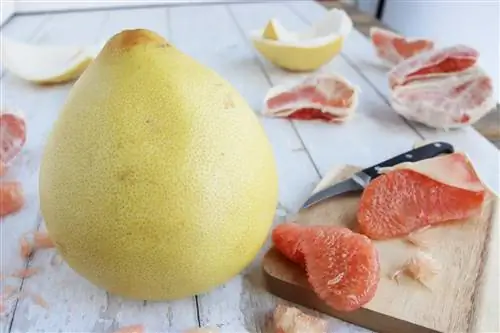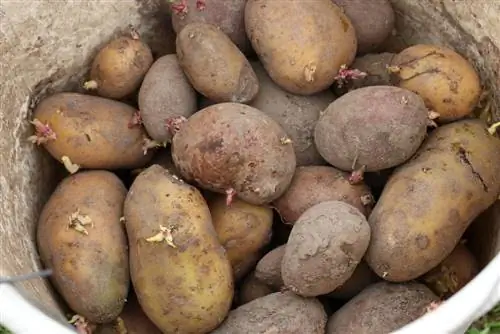- Author admin [email protected].
- Public 2023-12-17 03:39.
- Last modified 2025-06-01 06:48.
The pomelo is a cross between pomelo and grapefruit. This means that it is actually a backcross, as the grapefruit was created from the grapefruit by crossing orange and grapefruit.
What is a pomelo?
A pomelo is, so to speak, twice a grapefruit and once a grapefruit. Too complicated? In any case, the pomelo tastes a lot like grapefruit. Since hardly anyone knows what a pomelo tastes like anymore, that doesn't mean much, but you can at least imagine it based on the pomelo.
The pomelo is usually a little pear-shaped and weighs a mighty 500 grams to 2 kilograms with a diameter of 15 to 25 centimeters. The surface is white-yellow to green, underneath the pomelo has a thick white layer, which, like the separating membranes, can also taste bitter. The flesh itself is light yellow to pink, it tastes slightly sour and a little sweet.
Pomelo - nutritional values, calories, vitamins
The pomelo is low in calories, 0.1 kg of pulp has a calorific value of 25 to 50 kcal. The pulp contains very little fat, only 0.5 grams per 0.1 kg, and it contains just as much protein as well as 1 gram of fiber. However, the proportion of vitamin C is worth noting: 41 milligrams per 0.1 kg, which is almost half of the recommended daily requirement of 100 milligrams for a he althy adult. In addition, pomelos are rich in potassium, phosphate and magnesium, and the bitter substance limonin stimulates the intestines. It contains naringin, which helps lower blood pressure, and many bioflavonoids not only prevent the oxidation of vitamin C in the body, but also inhibit the release of histamine, which means pomelos can dampen allergic reactions.
Eating pomelos
The pomelos can be eaten raw as fruit, then the bitter peel and the partitions of the segments should be removed beforehand. They can also be made into juice, jam and jelly or chutney. If the peel comes from untreated fruit, it can be used for seasoning, in chutneys and in jams.
Where does the pomelo come from?
The pomelo is grown in Israel (where the backcross was created around 1970) and South Africa and imported from there. More recently, fruits from Southeast Asia and China have also been sold on the German market under the name Pomelo or Honey Pomelo. They are rounder and yellower and have a sweeter taste, although the bitter tone can also extend into the flesh. The Honey Pomelo has a thinner skin and few seeds.
You can sometimes read on the Internet that a pomelo is a cross between a bitter orange and a melon, and there is also a pamelo that was created from a grapefruit and a melon. This rumor is now being carried all over the internet, and you will probably come across it if you want to find out more about the pomelo. Don't believe it! According to current knowledge, such a cross would be a biological miracle; pomelo and melon not only belong to different plant families, but also to different orders in the plant system.
The naringin contained in grapefruit and pomelo interacts with various medications, so you should separate one-time medication intake from the consumption of these fruits. If this is a long-term medication, please ask your doctor about these interactions.





